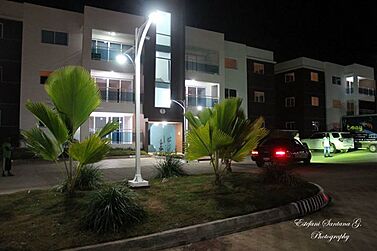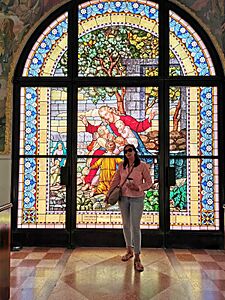Moca, Dominican Republic facts for kids
Quick facts for kids
Moca
|
||
|---|---|---|

Iglesia del Sagrado Corazón de Jesús in Moca, Dominican Republic
|
||
|
||
| Country | ||
| Province | Espaillat | |
| Municipality since | 1822 | |
| Area | ||
| • Total | 251 km2 (97 sq mi) | |
| Elevation | 183 m (600 ft) | |
| Population
(2022 census)
|
||
| • Total | 164,022 | |
| • Density | 653.5/km2 (1,692/sq mi) | |
| • Demonym | Mocano(a) | |
| Distance to – Santo Domingo |
145 km |
|
| Municipalities | 8 | |
| Climate | Af | |
| Website | http://am.gob.do/ | |
Moca is an important city in the Dominican Republic. It is the capital of the Espaillat province, located in the Cibao region. Moca is the tenth-largest city in the country, with about 164,000 people.
The city is about 18 kilometers (11 miles) east of Santiago, which is the second-largest city in the Dominican Republic. Moca is divided into eight smaller areas called municipal districts. These are San Víctor, Las Lagunas, José Contreras, Juan López, El Higuerito, La Ortega, Monte de la Jagua, and Canca La Reina.
Moca is also known as "La Villa Heroica," which means "Village of Heroes." This name was given because many people from Moca played a big part in the history of the Dominican Republic. They helped to remove two dictators, Ulises Heureaux and Rafael Trujillo, and bring democracy back to the country.
The city is home to the beautiful Corazon Sagrado de Jesus Cathedral. Its colorful stained-glass windows were brought from Italy. They show images of the apostles and Jesus' journey to the crucifixion. Farming is a main way of life for the people here. Crops like plantains and yucca are very important. Most of these crops are picked by hand.
Contents
Moca's Past: A Look at History
When the Spanish first arrived, the area where Moca is now was part of a chiefdom called Maguá. Moca was officially started in 1780. In 1845, it became a part of the La Vega department. Later, it became the main city of the Espaillat province.
Moca's Economy: How People Make a Living
Moca has a very active banking sector. You can find branches of all the country's main banks here. There are also many shops, furniture stores, supermarkets, and warehouses. The city has factories that make shoes, food, and building materials.
Moca is famous for its coffee industry, especially with a big company called Industries Banilejas. The city is also well-known for its farms. Plantains, bananas, and cassava are the most important crops grown here. Other fruits like oranges, lemons, grapefruit, and papaya are also grown. Many vegetables, such as lettuce, tomatoes, eggplants, peppers, and cabbage, are farmed too. Moca is also a major producer of chicken and eggs, providing about 70% of these products for the country.
Sacred Heart of Jesus Cathedral
The Corazon Sagrado de Jesus Cathedral is a very important building in Moca. It is a beautiful church with a rich history.
Moca's Geography: Where is it?
Moca covers an area of about 339 square kilometers (131 square miles). The city is built on a volcanic coral reef. To the west, there are hills, and to the north, you can find low mountains. These mountains are part of the Cordillera Septentrional range.
The highest mountain in Moca, and in the whole province, is El Mogote, which is 971 meters (3,186 feet) tall. Moca is located at an elevation of 183 meters (600 feet) above sea level. In 2023, the average temperature in the city was 27.5°C (81.5°F), and the average rainfall was 189.1 mm (7.4 inches).
Moca's Local Areas: Subdivisions
Moca is divided into several areas, each with its own population.
| Division | Status | Population (2022) |
|---|---|---|
| Canca La Reyna | District | 11,395 |
| El Higüerito | District | 11,343 |
| José Contreras | District | 4,296 |
| Juan López | District | 14,326 |
| La Ortega | District | 2,315 |
| Las Lagunas | District | 16,869 |
| Moca | Municipal Core | 97,196 |
| Monte de La Jagua | District | 6,282 |
Moca's Weather: Climate Information
Moca has a tropical climate. This means it is generally warm all year round. The table below shows the average temperatures and rainfall for Moca in 2023.
| Climate data for Moca, Dominican Republic (2023) | |||||||||||||
|---|---|---|---|---|---|---|---|---|---|---|---|---|---|
| Month | Jan | Feb | Mar | Apr | May | Jun | Jul | Aug | Sep | Oct | Nov | Dec | Year |
| Record high °C (°F) | 31.4 (88.5) |
32.2 (90.0) |
34.2 (93.6) |
34.9 (94.8) |
36.5 (97.7) |
36.9 (98.4) |
37.2 (99.0) |
36.4 (97.5) |
36.8 (98.2) |
36.3 (97.3) |
33.6 (92.5) |
32.6 (90.7) |
37.2 (99.0) |
| Mean daily maximum °C (°F) | 28.8 (83.8) |
29.7 (85.5) |
31.8 (89.2) |
32.3 (90.1) |
33.8 (92.8) |
35.0 (95.0) |
34.6 (94.3) |
33.4 (92.1) |
34.3 (93.7) |
33.1 (91.6) |
31.0 (87.8) |
29.8 (85.6) |
32.2 (90.0) |
| Mean daily minimum °C (°F) | 16.9 (62.4) |
16.8 (62.2) |
17.2 (63.0) |
21.3 (70.3) |
22.4 (72.3) |
23.7 (74.7) |
23.3 (73.9) |
23.6 (74.5) |
23.6 (74.5) |
22.9 (73.2) |
22.1 (71.8) |
19.9 (67.8) |
20.5 (68.9) |
| Record low °C (°F) | 12.1 (53.8) |
13.0 (55.4) |
15.9 (60.6) |
17.2 (63.0) |
21.1 (70.0) |
22.7 (72.9) |
21.8 (71.2) |
21.6 (70.9) |
22.9 (73.2) |
21.4 (70.5) |
20.3 (68.5) |
16.5 (61.7) |
12.1 (53.8) |
| Average rainfall mm (inches) | 30.2 (1.19) |
26.5 (1.04) |
37.9 (1.49) |
28.4 (1.12) |
45.5 (1.79) |
18.9 (0.74) |
29.8 (1.17) |
41.5 (1.63) |
23.7 (0.93) |
33.9 (1.33) |
37.3 (1.47) |
24.6 (0.97) |
378.2 (14.87) |
| Average rainy days (≥ 0.2 mm) | 6.0 | 6.5 | 4.0 | 7.5 | 10.0 | 6.5 | 6.0 | 9.0 | 6.0 | 6.5 | 8.0 | 6.5 | 82.5 |
| Source: NOAA | |||||||||||||
Famous People from Moca
- Trina de Moya (1863–1943) – She was a poet and also served as the First Lady of the Dominican Republic at different times.
Sports in Moca
- Estadio Bragaña Garcia – This is a baseball stadium in Moca, where local games are played.
See also
 In Spanish: Moca (República Dominicana) para niños
In Spanish: Moca (República Dominicana) para niños










